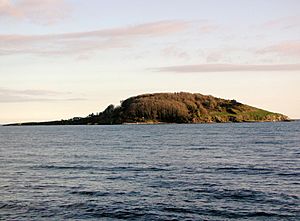Looe Island facts for kids
Looe Island, also called St George's Island, is a small island nature reserve. It's about a mile from the town of Looe in Cornwall, England. In the Cornish language, its name is Enys Lann-Managh, which means 'island of the monk's enclosure'.
Local stories say that Joseph of Arimathea visited the island with the young Jesus. Some experts also think this island might be Ictis. This was a place described long ago as a major center for trading tin before the Romans came to Britain.
Today, the Cornwall Wildlife Trust owns and looks after Looe Island. They manage visits carefully to protect the wildlife. You can only land on the island using the Trust's special boat. The waters around the island are also a special marine nature reserve. This area helps protect the sea creatures and plants near Looe.
Contents
Island History: From Ancient Times to Today
People have lived on Looe Island since the Iron Age, a very long time ago! We know this because old items have been found there. These include pieces of Roman pottery and ancient coins. Stone boat anchors have also been discovered.
Some people believe Looe Island might be Ictis. This was an important island for tin trading mentioned by ancient writers. In 2008, a small collection of eight Roman coins was found. These coins were from the late 3rd or early 4th century AD. They were found in a ditch that once surrounded the top of the island.
Early Christian Island Life
During the Dark Ages, Looe Island was an early Christian settlement. It was believed that the child Jesus visited the island with his uncle, Joseph of Arimathea. Joseph traded with the Cornish tin merchants. The island was already a holy place for early Christians. A small chapel with a thatched roof was built there during this time.
Later, in the medieval period, Glastonbury Abbey took control of the island. Monks from the abbey looked after the island's chapel. In 1289, the island was sold to a local landowner. The chapel then became a private one, looked after by a priest. When monasteries were closed down in 1536, the island became property of the King or Queen. From the 13th to the 16th centuries, it was called St Michael's Island. But in 1594, it was renamed St George's Island.
Smugglers and Wartime Stories
In the 17th and 18th centuries, smugglers used Looe Island. They used it to hide from government ships that were trying to stop illegal trade. The Old Guildhall Museum in Looe has lots of information about the smuggling families who used the island.
During the Second World War, Looe Island was even given a secret name: 'H.M.S St. George'. This happened after a bomb fell on the island, making a big hole. People thought the German pilot might have mistaken the island for an Allied ship. A local newspaper wrote about it, saying "H.M.S St. George is still riding peacefully at her anchorage in Looe Bay."
The Atkins Sisters and the Island's Future
In the 20th century, two sisters named Babs and Evelyn Atkins owned and lived on Looe Island. They wrote two books about their life there: We Bought An Island and Tales From Our Cornish Island. Evelyn passed away in 1997, and Babs continued to live on the island until her death in 2004.
When Babs died, she left the island to the Cornwall Wildlife Trust. This means the island will always be a nature reserve. Today, wardens from the Trust live on the island. They work hard to protect its wildlife. A small island next to Looe Island, now called Trelawny Island, was given back to the Trelawny family. They had owned Looe Island many years before.
Island Geography: Size and Visits
Looe Island is in the English Channel. It's about one mile from East Looe. The island is about 22.5 acres in size, which is like 17 football fields. It's about 1.6 kilometers around. The highest point on the island is 47 meters above sea level. Looe Island has a mild climate, meaning it rarely gets frost or snow.
The Cornwall Wildlife Trust manages the island. Any money from landing fees helps them protect the island's nature. The island is open to visitors during the summer. You arrive by the Trust's special boat. After a short welcome talk, you can visit the small visitor center. From there, you can get a map for a self-guided walk. Visitors usually have about two hours on the island. Trips depend on the tides and the weather.
Sometimes, at very low tides, it's possible to walk to the island from the mainland. But the sea floor is rocky and covered in slippery seaweed. If you do walk, you must stay on the beach and quickly return to the mainland.
Media Appearances: TV and Music
In 2008, the Channel 4 archaeology TV show Time Team visited Looe Island. They explored the island's early Christian history. They dug up sites where Christian chapels were built. They found the remains of a Benedictine chapel built around 1139 by monks. They also found graves and older places of worship made of wood. These findings suggest that Christians were on the island even before the time of Constantine the Great.
In 1994 and 1995, a composer named Andrew Hugill created a piece of music called Island Symphony. This music used sounds from the internet and natural sounds recorded on Looe Island itself.



